Friday, October 30, task for the day: 2 retreat sessions and marketplace (again)
On Friday, I once again woke up bright and early (damn you, jetlag!) and was ready to go to my first retreat session, Spinning for Next to the Skin taught by Sarah Swett. One of my roommates was in my class and she was able to tell me about Sarah's tapestries. Previously, I hadn't seen any of her tapestries which was a real shame. They are like paintings from wool. Sarah brought a series of them to show us and it was almost like a comic strip.
Sarah also brought a number of different handspun sweaters, dresses, and coats which she has spun and knit. I loved the green dress that she made and it was sooooo soft.
Sarah explained wool structure to us and why some wool is better than others for garments meant to be worn next to the skin. For some people, the direction of the scale in wool fibers can make it feel pricky to them. Of course, some of us can't tell the difference at all. Sometimes it is the difference in preparation. She had some washed locks of Rambouillet, Polwarth and what we thought was Cormo for us to prep and spin.
The reason I said what we thought was Cormo is because Sarah had it labeled that way until the man who provided the fleeces said it was actually Polwarth. He happened to be in our class because his wife was attending SOAR and he came along, too. It was very valuable to have him there because he was able to tell us so much information about the history of the breed (as well as cormos), raising sheep in a large herd situation, and much more. Of course, right now I wish I hadn't lost the paper where I wrote down all of his information. Anyway, ready for a brief history of the Polwarth breed? (Sidenote: turns out the breed is called PolwArth not PolwOrth. Who knew?)
Picture from the New Zealand Sheep Breeders Association
According to the Polwarth Sheepbreeders Association, the breed was established in 1880. It's origin is in Australia/New Zealand from crosses of Saxon Merino rams and Lincoln ewes (3/4 Merino and 1/4 Lincoln). It is a very vestile breed that can thrive in very diverse climates, produce fine fleeces, are a good meat sheep, are good mothers and can lamb all year. An average fleece has a micron count of 23-25 and a Bradford count of 58-60's. Fleeces can range in weight from 13-15 pounds (which blows my mind) and the staple length is 4-6 inches. The farmer in our class estimated that there is about a 75% yield rate for the fleeces. Because there aren't many Polwarth breeders in America (or Australia for that matter)and supply and demand being what it is, there is a high demand for fleeces.
Sarah handed out pieces of heavy cardstock/matting board so we could record what prep method we used, the wool type and spinning style for each sample. Because I love a 3-ply yarn, I did 3 ply samples for each type.
(picture of sample card)
I loved the gray locks to death. I kept petting my samples because it was just so soft. My combed fiber was MUCH finer than the carded fiber even when I did the same spinning methods. If I wanted to have something soft but with a lot of air in it, I would definitely card the Polwarth. Sarah was nice enough to give us a large enough sample to be able to make a small project like a cowl.
A random tip/trick I learned during the class came from a fellow student. You know those weaving bobbins that people use to ply or to wind their singles off of a drop spindle? Well, they are a pain to wind by hand and the bobbin winders that you can buy range from $95-120 (or more). She had a drink stirrer from which she cut the ends off which fits in the bobbin. You can find the electronic stirrer wherever there are those powder drink sport mixes. They are around 5 bucks, are handheld and take AA batteries. Talk about genius! On the way home from the airport, I stopped by a grocery store and picked one up.
After class, everyone headed to lunch and then on to the second session of the day. My second session was one about which I was very excited. I took Making the Most of Your Hand-held Combs by Robin Russo. I didn't realize it but Robin and her husband are the force behind the St. Blaise wool combs. If I didn't already have my set of Alvin Ramer super mini combs, I would be sorely tempted by their mini combs.
Robin brought a couple of different kinds of mini combs for us to use. She had a few sets with their tines set far apart which would be appropriate for certain kinds of wool (not fine fibers). The St. Blaise sets have their tines set closer and are appropriate for the widest range of fibers from wool to alpaca, etc. Finally, she had two sets of very fine combs for combing the angora. Those combs were much smaller than the others. The tines were very fine, set very close together and were shorter than the other sets.
I love combed fiber. The way it spins is just lovely to me. I can always get combed fiber to be a much thinner yarn without bumps and burbles (why, yes, that is a word). But I felt like I wasn't using my hand-held combs to their full advantage. I was hoping that this class would help me over come that concern and it definitely did. Also, the class gave me ideas for things I could do with the mohair fleece I bought last year. Yay!
First, we samples of three different wools: fine, medium, and coarse. The fine breed was Polwarth (apparently for me, Polwarth was the wool type of SOAR), the medium was Romney and the coarse was Coopworth. Of course, the Coopworth wasn't really as coarse as some other fibers out there but it was the coarsest in our wool sample.
After getting used to working with wools, we moved on to fibers which need to be dehaired before you spin them. If you don't dehair llama, for instance, it would feel extremely itchy because the guard hairs are thicker and more coarse than the rest of the hair. Our two fibers were llama and Navajo Churro, a sheep breed known for its dual coats. Rugs and other hard wearing items are woven from this wool because it is so hardy. We separated the coarse top coat from the downy undercoat. I spun up a sample from both coats just to see the difference. The top coat was almost like spinning with fine wire, it was that coarse! The undercoat was still coarser than some breeds but was much better than the top coat. It was also a much darker brown than the top coat.
We moved on to exotic fibers next which were mohair, angora and alpaca. I've knit with all of these fibers before but had never spun much less combed them. I was really excited to do the mohair because last year I bought a fleece off of a local woman. I've wanted to use it but have been worried about messing it up. Robin advised us to tease the locks open as much as possible so you almost have a cloud of mohair before combing. That way you will won't have as much loss while combing. Combing the angora was just like combing a cloud, difficult and whispy! I think I need a lot more practice before I do a lot of angora prepping. The alpaca was similar (of course) to llama but with much finer guard hairs.
The final thing we did, if we had time, was playing with blending fibers on the combs. I ended up spending my remaining time practicing blending mohair and wool because that is what I want to do with my mohair fleece. I took some mohair that was dyed golden and blended it with some green wool then red and then white. It gave the blend a hint of gold and I really liked the way things turned out.
Robin stressed to us that, with fibers other than wool, you should only use water to dampen down the static. Oil of any sort gunks up non-wool fibers. She gave us a recipe for what she calls combing milk for combing wool. I liked the way it smelled and the oil kept my hands nice and moisturized.
After class was over, I went over to the marketplace again to browse around. I bought some weaving bobbins to use for plying once I got home. That idea of using a drink stirrer was just so perfect that I had to pick up some bobbins (and not have to pay shipping!)
After dinner, they were having the fastest spinner contest. There were two categories: wheel spun and spindle spun. The 10 contestants in each category had a pit crew and cheering sections. They all spun their hearts out for 15 minutes. It was hysterical! I bet the resort staff never knew spinners could be so loud! My favorite person of the night was the lady standing on her chair with her spindle so she could get a longer single before winding it on. She would yell, "Liquor! Liquor!" and one of her pit crew would hold up a wine glass with a straw in it so she could stay "hydrated."
Once spinning was halted, the measuring began. They used one hallway to measure distances. The wheels of course had the most distance but the spindles produced the finer singles with some being upwards of 80 WPI! I can't remember how long the winning spindler's single was but the wheeler's was 2 hallways and a bit. The distances will be listed in the next Spin Off magazine.


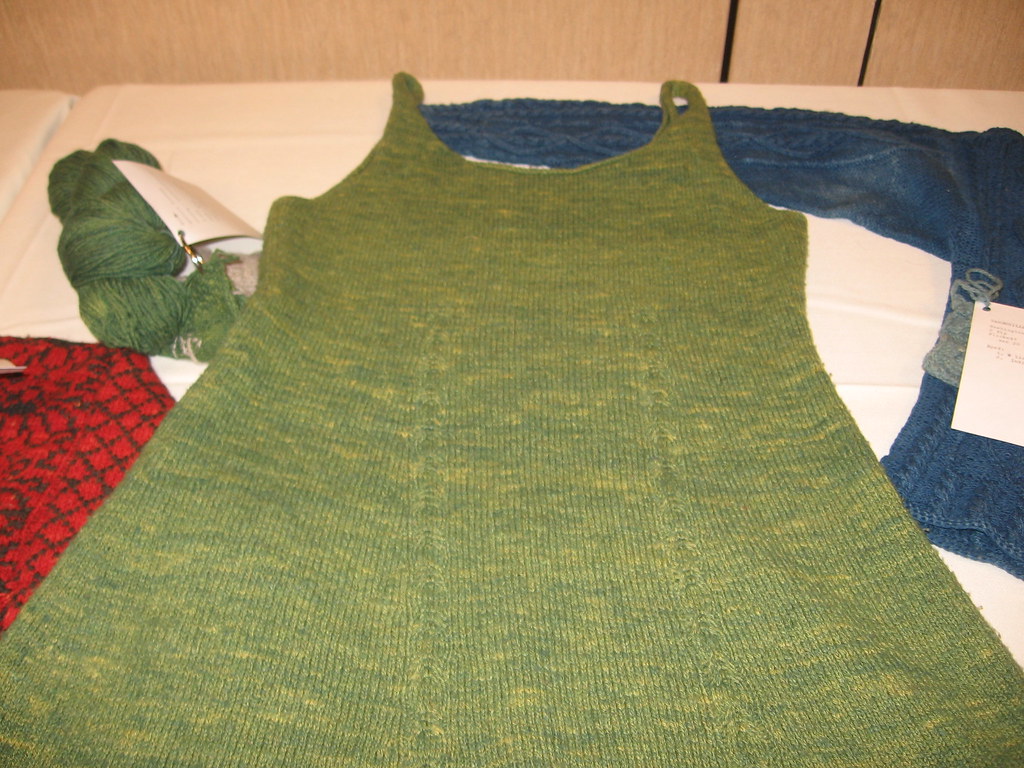



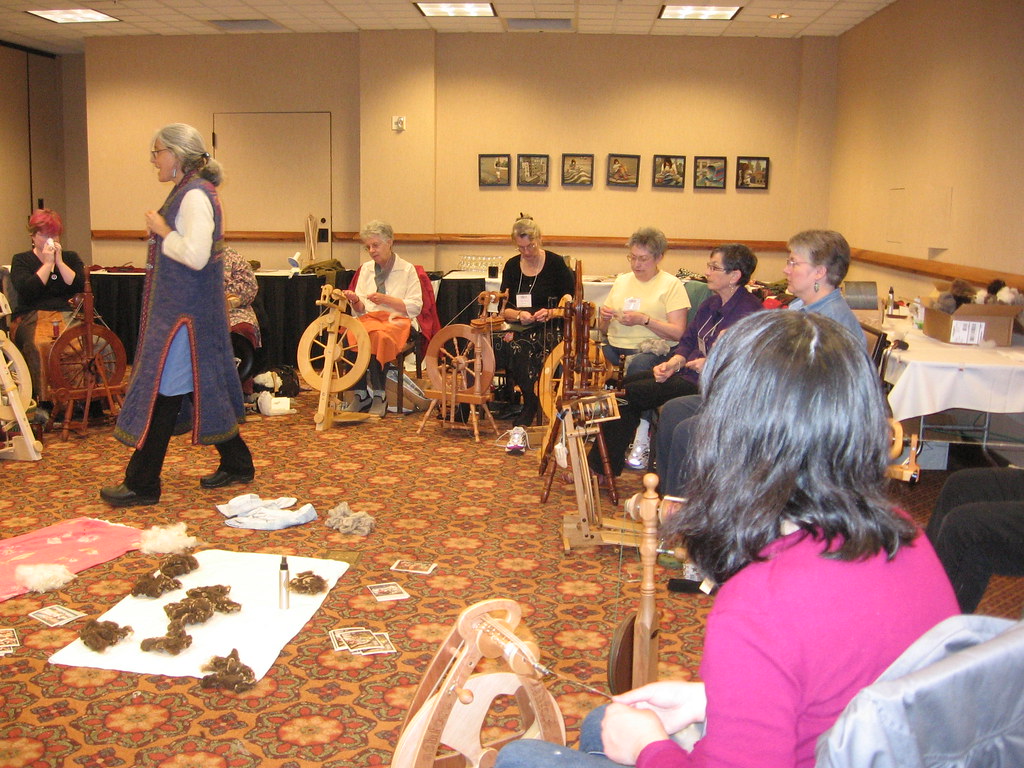
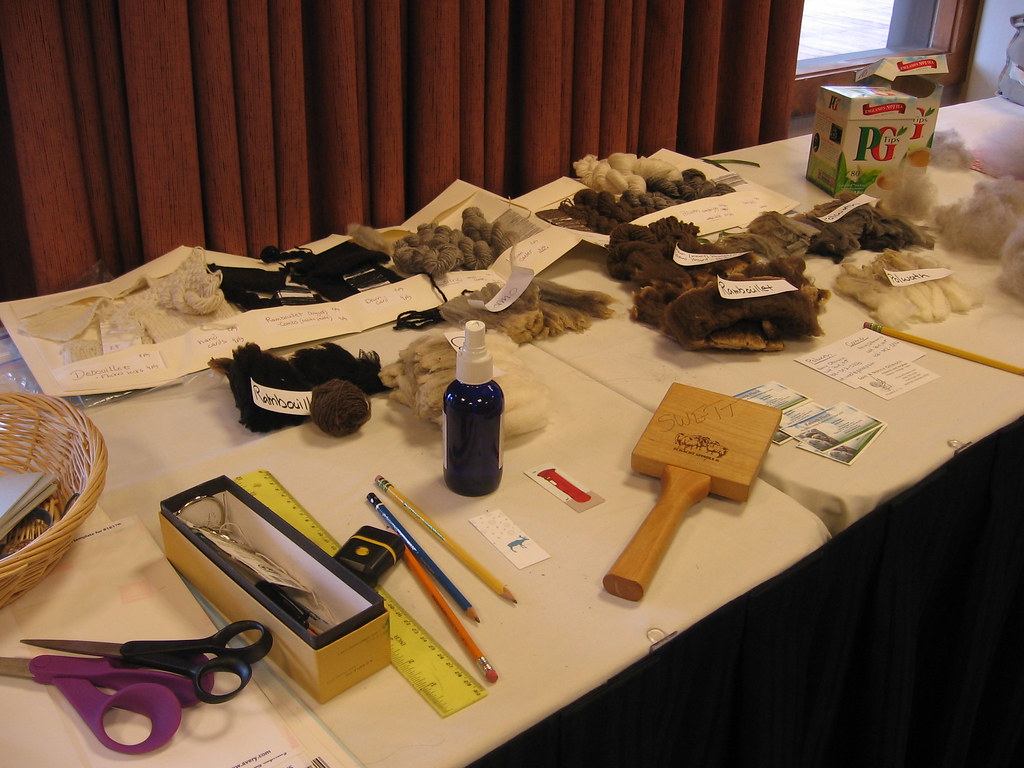

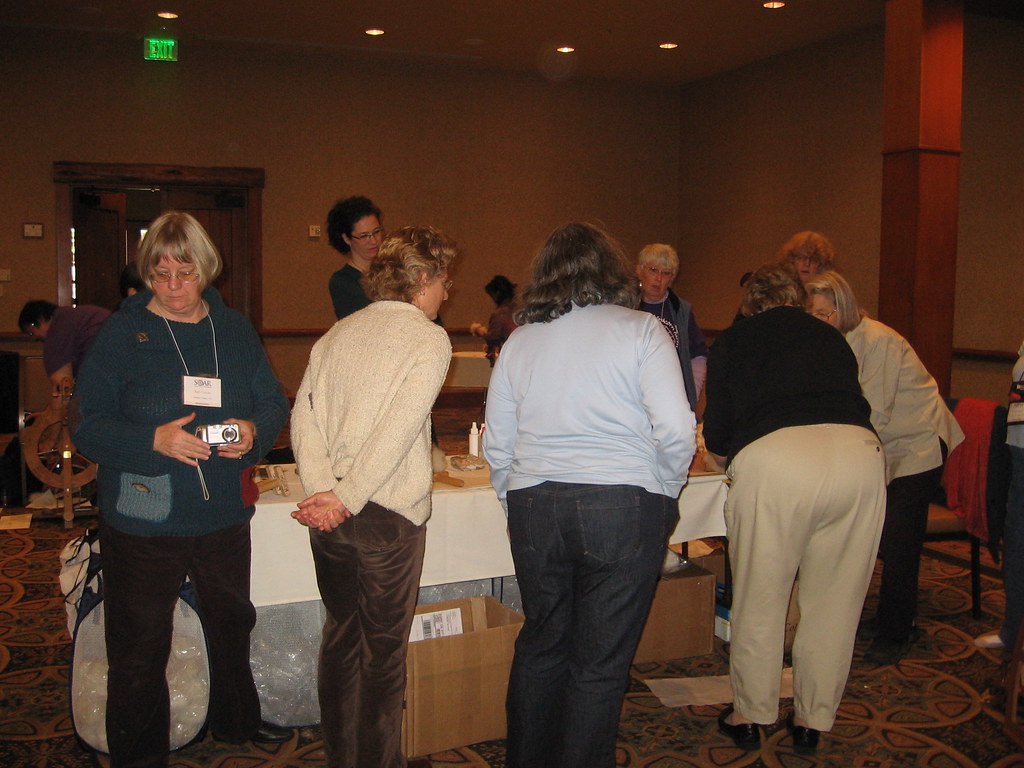
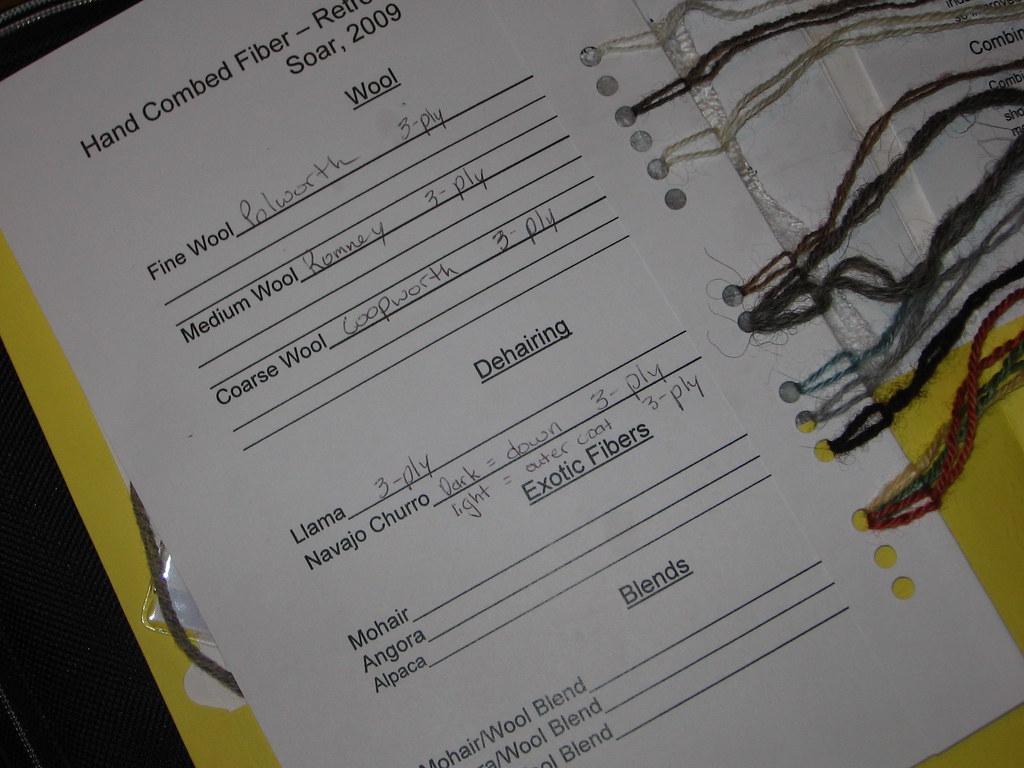

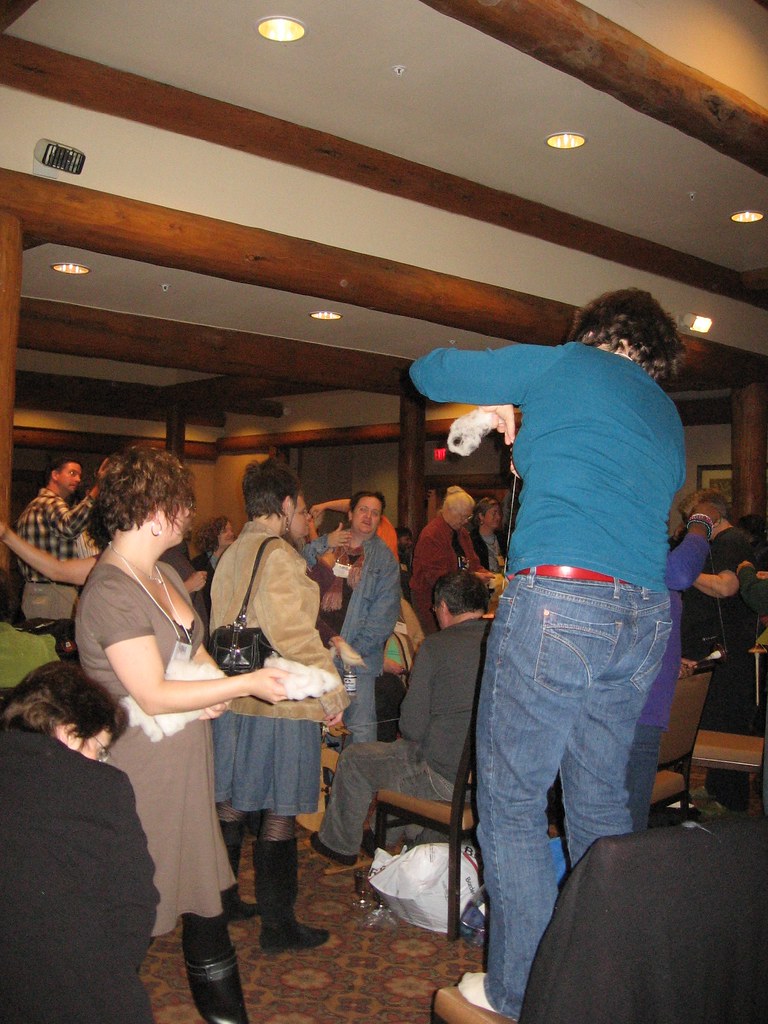
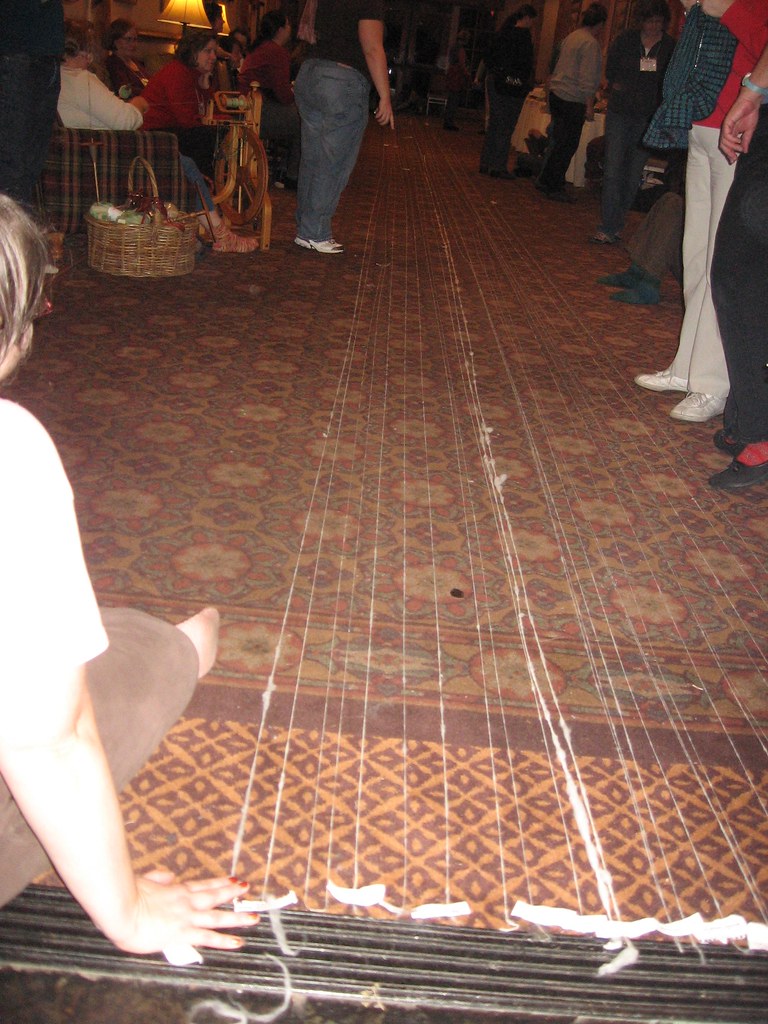







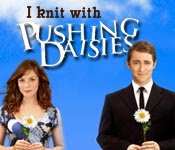

1 comment:
Oh didn't you just LOVE that green knitted dress? I saw a woman trying it on in the washroom by the dining hall and it looked soooo good on her. I have never in my life thought to knit a dress, but slowly my curiosity is peaked.
I love your updates :) Thank you!
Post a Comment